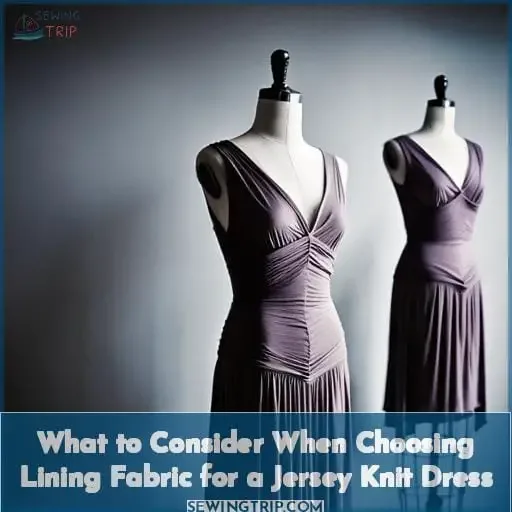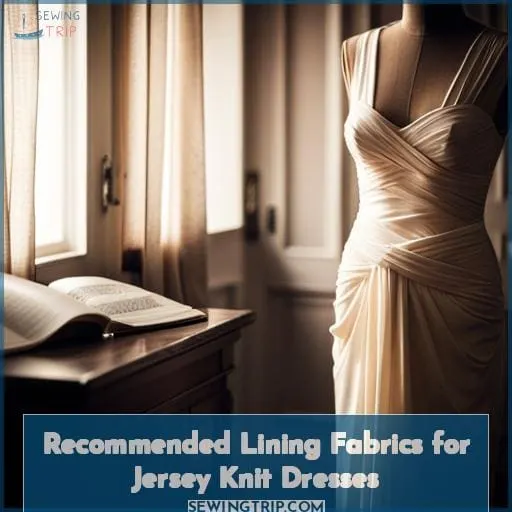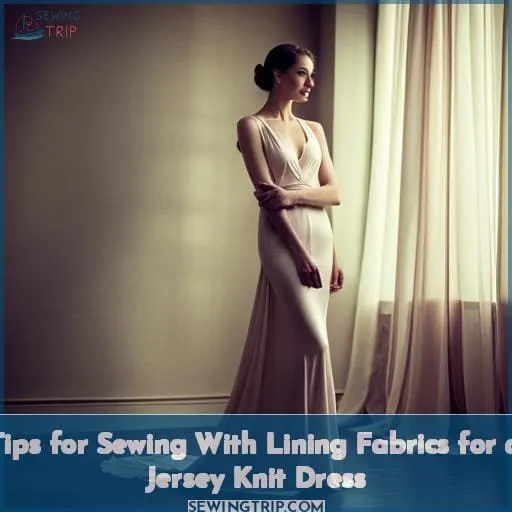This site is supported by our readers. We may earn a commission, at no cost to you, if you purchase through links.
 Ah, the joys of sewing! What could be more satisfying than creating a beautiful new garment for yourself or someone you love? But when it comes to jersey knit dresses, finding the right fabric for lining can feel like an insurmountable task.
Ah, the joys of sewing! What could be more satisfying than creating a beautiful new garment for yourself or someone you love? But when it comes to jersey knit dresses, finding the right fabric for lining can feel like an insurmountable task.
To help make this process easier and ensure your dress looks its best in every situation, let’s take a look at what makes up the best fabric for lining a jersey knit dress. From stretchiness to breathability and color selection – we’ll cover all of these factors so that you can choose the perfect material to keep your style lasting through any occasion.
Table Of Contents
- Key Takeaways
- Why Do You Need a Lining for a Jersey Knit Dress?
- What to Consider When Choosing Lining Fabric for a Jersey Knit Dress
- Recommended Lining Fabrics for Jersey Knit Dresses
- How to Choose the Best Lining Fabric for Your Jersey Knit Dress
- Where to Find High-Quality Lining Fabrics for Jersey Knit Dresses
- Tips for Sewing With Lining Fabrics for a Jersey Knit Dress
- How to Care for a Jersey Knit Dress With Lining
- Common Mistakes to Avoid When Choosing Lining Fabric for a Jersey Knit Dress
- Alternatives to Lining for a Jersey Knit Dress
- Conclusion
Key Takeaways
- Lining enhances the comfort and style of a jersey knit dress.
- Factors for selecting lining fabric include stretchiness, anti-static properties, breathability, comfort, color, and opacity considerations.
- Recommended lining fabrics include stretch jersey lining, cotton blend lining, cupro lining, and silk lining.
- Matching the stretch and drape of the lining to the dress fabric is important for harmonious movement.
Why Do You Need a Lining for a Jersey Knit Dress?
Imagine slipping into a beautifully draped piece that feels like a second skin, offering a seamless surface that enhances your every movement while providing that essential layer of breathability and comfort, transforming your experience with just the right touch of practical elegance.
The role of a lining in a jersey knit dress goes beyond mere practicality—it’s a decision that can elevate your comfort and style. A well-chosen lining fabric, like a breathable cotton voile, not only addresses the transparency issue of jersey knits but also enhances the overall structure of the dress.
However, there are considerations. While the right lining adds comfort and opacity, an ill-suited one might compromise stretch and drape. Modern trends emphasize both sustainability and luxurious texture, influencing lining choices.
Keep in mind that the lining’s role isn’t just about comfort; it’s about mastery over your outfit’s fit and feel, ensuring your confidence shines through.
What to Consider When Choosing Lining Fabric for a Jersey Knit Dress
When selecting lining fabric for your jersey knit dress, you should prioritize three key factors: stretchiness and anti-static properties, breathability and comfort, as well as color and opacity. These considerations are vital to ensure your dress not only fits and drapes well but also feels comfortable to wear, prevents static cling, and maintains the desired color and opacity levels.
Stretchiness and Anti-Static Properties
Embrace a fabric’s elasticity like a second skin, ensuring it resists both clinginess and electric charges, a crucial harmony in a knit ensemble. When selecting lining fabric for your jersey knit dress, prioritize stretchiness and anti-static properties.
Opt for a stretch lining that mirrors the fluidity of the knit fabric, allowing unrestricted movement. Consider anti-static lining to prevent discomfort caused by electric charges, maintaining the dress’s elegance and your comfort throughout wear.
Material compatibility, particularly with polyester-based jersey knits, ensures lasting durability and performance.
Breathability and Comfort
Prioritize the airiness and comfort you desire, allowing a refreshing flow of breath that seamlessly weaves with your chosen garment, amplifying the pleasure of each wear. Opt for a lining that excels in moisture management and heat regulation, ensuring you stay cool and comfortable.
Consider silk or viscose linings for their exceptional breathability and layering benefits. Balance fabric weight with clothing comfort, as a lightweight, breathable lining elevates your overall experience.
Color and Opacity
Consider how the interplay of vibrant hues and translucency can influence the overall allure of your ensemble.
-
Opacity Variations: Choose a lining fabric with opacity that complements your jersey knit dress. Ensure it offers the right level of coverage for your comfort and style.
-
Color Matching: Opt for a lining color that matches or enhances your dress color, creating visual harmony in your outfit.
-
Sheer Overlay: Experiment with sheer overlay options by selecting a lining that allows your jersey knit dress to shine through in strategic areas, adding an alluring dimension to your look.
When selecting your lining fabric for a jersey knit dress, consider how these factors contribute to the overall fabric layering and drape, enhancing your ensemble’s appeal. Whether it’s the delicate silk habotai lining, versatile polyester lining, or stretch jersey lining, the right choice will elevate your dress to a new level of sophistication.
Recommended Lining Fabrics for Jersey Knit Dresses
Turning to the realm of lining choices for your jersey knit dresses, you’ll want to consider a quartet of optimal options: Stretch Jersey Lining Fabric, Cotton Blend Lining Fabric, Cupro Lining Fabric, and Silk Lining Fabric.
Each of these brings distinct attributes to the table, from the flexibility and anti-static properties of stretch jersey to the breathable comfort of a cotton blend, the prized durability of cupro, and the delicate elegance of silk.
Tailoring your lining selection to the demands of your jersey knit creation has never been more comprehensive.
Stretch Jersey Lining Fabric
Get ready to amp up the comfort and flexibility of your jersey-style masterpiece by diving into the world of stretchy companions for your creation. When selecting a stretch jersey lining fabric, consider its stretchiness, which should match the elasticity of the jersey knit dress.
Ensuring color harmony is crucial for a seamless look. Employ stitching techniques that allow for fabric movement. Layering options, such as using a lightweight jersey lining, can enhance the dress’s drape.
Fabric sourcing is easier online, offering an array of choices to elevate your garment.
Cotton Blend Lining Fabric
Opt for a cotton blend that seamlessly complements the texture and stretch of your jersey knit, adding an extra layer of comfort and breathability to your creation.
-
Cotton Blend Advantages: Cotton blends offer a balance of softness and durability, ensuring your dress feels great and lasts.
-
Lining Color Options: Match or contrast the lining color to your dress for creative flair.
-
Stitching Techniques: Use stretch stitches to prevent puckering and maintain the fabric’s elasticity.
-
Lining Weight Considerations: Opt for a lightweight cotton blend to avoid bulkiness in your dress.
Cupro Lining Fabric
Indulge in the luxurious feel of Cupro, a lining choice that’s prized for its durability, breathability, and affordability, adding an extra layer of comfort to your ensemble.
Cupro lining advantages go beyond its softness; it wicks moisture away, keeping you cool in your jersey dress. Styling with cupro elevates your outfit’s elegance, akin to silk, yet without the high cost.
Comparing cupro and silk, you’ll find cupro offers similar advantages at a friendlier price point. When it comes to jersey dress comfort, cupro’s lightweight and silky touch will make you forget you’re wearing an additional layer.
To care for cupro lining, opt for gentle laundering, ensuring its longevity while maintaining its lustrous appeal. Enjoy the transformative effect of cupro lining – it’s your gateway to dressing with confidence and comfort.
Silk Lining Fabric
Immerse yourself in the luxurious embrace of silk, a fabric that caresses your skin with an unrivaled delicacy and lustrous elegance, enhancing the allure of your chosen attire. Silk lining is a sublime choice for jersey knit dresses, offering a harmonious blend of comfort and sophistication.
The benefits of silk lining are manifold: it provides exceptional breathability, ensuring you stay cool even on balmy days. It also offers a subtle opaqueness that complements the outer fabric. When considering lining color, keep in mind that silk can enhance or subtly alter the overall hue of the dress, adding a touch of intrigue to your ensemble.
Stitching silk linings requires finesse, as this delicate material can be prone to fraying. However, with proper handling and stitching techniques, silk linings can endure with remarkable durability.
Selecting the right silk lining involves weighing the dress’s characteristics and the desired lining qualities. From enhancing the drape of the jersey knit fabric to providing a luxurious feel against your skin, silk lining ensures your jersey knit dress exudes both comfort and allure.
How to Choose the Best Lining Fabric for Your Jersey Knit Dress
Exploring the ideal lining fabric for your jersey knit dress involves a meticulous evaluation of several crucial factors. Match the stretch and drape of your dress fabric by selecting a lining that complements these characteristics, ensuring a harmonious fit.
Consider the weight and thickness of the lining fabric, as it should enhance the dress’s structure without adding unnecessary bulk.
Furthermore, evaluate the breathability and moisture-wicking properties of the lining to guarantee comfort during wear.
Lastly, assess the color and opacity of the chosen lining fabric, as these attributes influence the overall appearance and visual appeal of your jersey knit dress ensemble.
Matching the Stretch and Drape of the Dress Fabric
Explore how to seamlessly match the elasticity and fluidity of your attire’s material by carefully selecting a complementary inner layer that effortlessly mirrors the stretch and graceful draping of your ensemble.
Achieving stretch matching and drape consistency is essential to maintain the fabric compatibility and elasticity balance. Consider the specific qualities of your jersey knit dress, such as its stretchiness and drape, when choosing the lining material.
This harmony ensures comfort, ease of movement, and fabric maintenance, while also guaranteeing outer fabric compatibility.
Considering the Weight and Thickness of the Lining Fabric
Delve into the realm of material attributes, where the weight and thickness of the layer beneath your creation play a pivotal role in sculpting its ultimate form.
-
Lining Weight Considerations: The weight of your lining fabric affects the overall drape and silhouette of your jersey knit dress. Opt for a lining that complements the weight of your dress fabric, ensuring a harmonious flow.
-
Layering Options: The thickness of your lining impacts layering possibilities. A lightweight lining, like acetate or bemberg, offers ease of movement and prevents bulkiness when layering, while thicker options like viscose or cupro provide more structure.
-
Lining Color Impact: Keep in mind that the color of your lining can influence the appearance of your dress. Choose a lining shade that enhances the vibrancy of your dress fabric or coordinates with your design’s aesthetics.
-
Heat Regulation Aspects: Consider the climate you’ll be wearing your dress in. Lining material thickness contributes to heat regulation. Lighter linings like silk satin allow for breathability in warmer conditions, while heavier options provide insulation during cooler times.
Evaluating the Breathability and Moisture-Wicking Properties
Plunge into the realm of comfort and airiness as you assess the breathability and moisture-wicking capabilities essential for an exhilarating experience in your jersey knit creation. The right lining fabric can contribute to moisture management, offering a cooling effect.
A thin lining aids in heat dissipation and prevents fabric interaction problems. Opt for fabrics like satin or silk habotai to ensure optimal comfort and effective moisture control in your dresses.
Assessing the Color and Opacity of the Lining Fabric
Take a moment to consider the color and opacity of the fabric you’re eyeing, ensuring it beautifully complements your chosen outer layer while offering the perfect level of coverage.
Here’s what to keep in mind:
-
Lining Color Analysis: Opt for a lining color that harmonizes with your dress color, either blending discreetly or creating a stylish contrast.
-
Opacity Considerations: Evaluate how transparent the lining fabric is. A slightly opaque lining can help manage jersey knit’s inherent transparency.
-
Color Matching Tips: Test the lining fabric under different lighting conditions to ensure it maintains its color integrity against your dress fabric.
-
Lining Fabric Depth: Select a lightweight lining to avoid bulk while maintaining the dress’s structure. Fine woven fabrics like cotton canvas can provide structure without adding weight.
Where to Find High-Quality Lining Fabrics for Jersey Knit Dresses
Explore a range of fantastic options as you search for top-notch materials to enhance the inner beauty of your favorite stretchy ensemble!
When it comes to sourcing options for lining fabrics suitable for your jersey knit dresses, online retailers offer a plethora of choices to consider.
For those seeking supreme quality, materials like Bemberg rayon and China silk present excellent lining options.
These materials boast a delicate touch while providing breathability and comfort, making them ideal for summer dresses or even exquisite wedding gowns.
When making your selection, keep in mind the specific characteristics that align with your dress’s requirements.
The world of lining fabrics opens up a world of possibilities to elevate your dress-making prowess, empowering you to craft garments that exude both style and comfort effortlessly.
Tips for Sewing With Lining Fabrics for a Jersey Knit Dress
Sure, let’s explore the essential aspects of sewing with lining fabrics for a jersey knit dress. Make sure to carefully prepare your fabric and pattern, ensuring they are aligned. Handle and cut the lining fabric with precision, then utilize adept sewing techniques and seam finishes.
Finally, skillfully attach the lining to the dress, enhancing its overall quality and comfort.
Preparing the Fabric and Pattern
Get your materials and pattern ready, ensuring they are well-prepared and matched for a seamless sewing experience. Begin by laying out your jersey knit fabric, smoothing any wrinkles, and aligning the selvages.
Double-check the pattern’s grainline against the fabric’s stretch direction. Precision is key for a flattering fit. While cutting, consider interlining for added structure. Focus on seam alignment to prevent puckering.
Handling and Cutting the Lining Fabric
Handle the lining material with care, ensuring its smoothness and alignment, before proceeding to cut the fabric using the same pattern as the outer layer, maintaining consistent precision throughout.
Here are some crucial steps to master:
-
Seam Allowances: Maintain uniform seam allowances between the lining and the outer fabric to ensure a balanced fit.
-
Pattern Alignment: Double-check that the lining pattern aligns perfectly with the dress pattern to avoid any distortion.
-
Fabric Grain: Ensure the lining’s grain matches the outer fabric for proper drape and movement.
-
Pinning Methods: Use fine pins to prevent damage to the delicate knit material while keeping both layers securely aligned.
-
Handling Clingy Knits: For jersey knit dresses, select a lining with anti-static properties to prevent clinging and bunching.
Skillfully applying these techniques will lead to a flawlessly lined jersey knit dress that embodies your mastery of dressmaking.
Sewing Techniques and Seam Finishes
Mastering refined sewing techniques and skillful seam finishes is essential when working with delicate textiles, elevating the overall craftsmanship of your elegantly tailored creation.
Begin by selecting a suitable thread for your jersey knit dress and lining fabric. Use a ballpoint needle to prevent snags and maintain fabric integrity. Secure layers with pins or clips to prevent shifting during stitching.
When hemming, consider the fabric’s drape. A rolled hem complements lightweight linings, while a twin needle finish adds sophistication to heavier options.
Overcome stitching challenges by using tissue paper under the fabric or a walking foot attachment.
Attaching the Lining to the Dress
Navigating the realm of seamless integration involves ensuring the concealed inner layer elegantly melds with its outer counterpart, creating an embrace that harmonizes both without revealing the intricate mechanics beneath.
-
Understitching Magic: Employ understitching to anchor the lining, preventing it from rolling to the garment’s front.
-
Slip Stitch Serenity: Employ the invisible slip stitch for an undetectable bond that keeps the lining secure without disrupting the outer fabric’s drape.
-
Stitch-in-the-Ditch Precision: Seam intersections can be cleverly concealed by sewing in the ditch, creating an immaculate finish.
-
Topstitching Finesse: Strategically employ topstitching to bolster the lining’s adherence while adding a stylish touch.
-
Edge Stitching Elegance: Employ edge stitching along hems and edges for a polished look that holds the lining neatly in place.
With these Lining Stitching Methods, the Lining Anchoring Process becomes an art of liberation, empowering you to master the art of sewing while ensuring the harmonious union of comfort and style in your jersey knit dress.
How to Care for a Jersey Knit Dress With Lining
Addressing the maintenance of your jersey knit dress with lining involves mastering key aspects of care. You’ll need to navigate washing and drying instructions while also mastering the art of storage and wrinkle prevention to ensure your garment stays impeccable and ready to wear.
Washing and Drying Instructions
Tackle caring for your jersey knit ensemble by following these washing and drying instructions to ensure its longevity and appeal.
When dealing with a lined jersey knit dress, consider the lining material selection while laundering. Turn the dress inside out to protect delicate linings. Opt for a gentle cycle with cold water and a mild detergent.
When drying, lay the dress flat on a towel to prevent stretching and distortion. Steer clear of direct sunlight to prevent color fading.
This maintenance approach guarantees your jersey knit dress retains its allure and comfort over time.
Storage and Wrinkle Prevention
Embrace a clever trick: when your cozy ensemble meets its resting place, a deft fold-flat storage keeps those pesky creases at bay, ensuring your favorite go-to remains effortlessly stylish. To maintain your jersey knit dress with lining, delicately fold it to prevent creasing.
Consider layering tissue paper between folds to minimize friction. For stubborn wrinkles, spritz with a wrinkle release spray and gently smooth with your hands. If hanging, use padded hangers to preserve the garment’s shape. Traveling? Roll your dress instead of folding to minimize creases during transit.
Common Mistakes to Avoid When Choosing Lining Fabric for a Jersey Knit Dress
Avoiding common pitfalls when selecting the inner material for your knit outfit involves understanding its properties and how they complement your chosen outer fabric.
-
Fabric Stretch Issues: Opt for a lining with similar stretch and recovery as your jersey knit to prevent puckering and distortion.
-
Color Matching: Test the lining fabric against your dress fabric under different lighting conditions to avoid any unwanted show-through.
-
Opacity Concerns: If your knit dress is sheer, choose a lining that provides the desired level of coverage without compromising comfort.
-
Fabric Weight Impact: Consider how the weight of the lining will affect the drape and silhouette of your dress. A heavy lining can alter its intended look.
-
Breathability: Knit fabrics can be warm, so select a breathable lining material to ensure comfort, especially during extended wear.
Mastering the art of selecting the right lining fabric for your jersey knit dress empowers you to create a harmonious and comfortable ensemble that enhances your confidence and style.
Alternatives to Lining for a Jersey Knit Dress
Transitioning from common mistakes in lining fabric selection, let’s explore intriguing alternatives for lining a jersey knit dress. These options not only address potential mishaps but also offer a fresh take on achieving the desired effects.
Embrace invisible support by considering self-supporting dress designs that eliminate the need for additional lining layers. Layering becomes your creative playground – experiment with transparent knits over contrasting undergarments for a chic look.
Elevate your style with printed camisoles that add flair and coverage simultaneously. Alternatively, embrace liner-free styling by selecting high-quality, well-constructed jersey knit fabrics that require minimal lining.
Your journey to mastering jersey knit dress linings involves harnessing innovative techniques to achieve comfort, confidence, and charm.
Conclusion
Certainly, selecting the best fabric for lining a jersey knit dress can be a challenge. From considering factors like stretchiness and anti-static properties, to assessing breathability, color, and opacity, the task of finding the perfect lining can require patience and plenty of research.
Fortunately, there are several options available. These include stretch jersey lining, cotton blend lining, cupro lining, and silk lining. When choosing the best fabric for lining a jersey knit dress, it’s important to match the stretch and drape of the dress fabric.
Additionally, evaluating the weight and thickness of the lining fabric, as well as assessing its breathability and moisture-wicking properties, is crucial.
Careful consideration and attention to detail can ensure that you find the perfect fabric for lining a jersey knit dress and take your dress-making to the next level.















